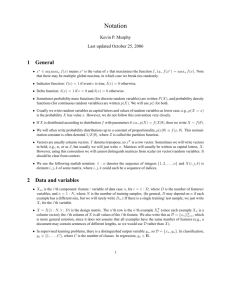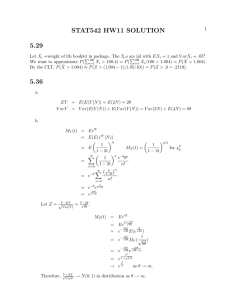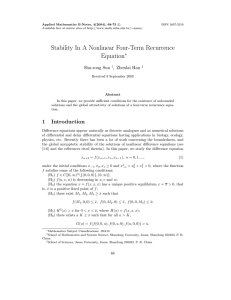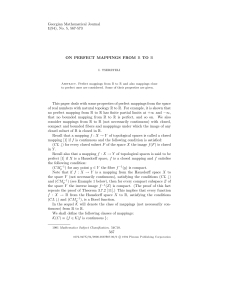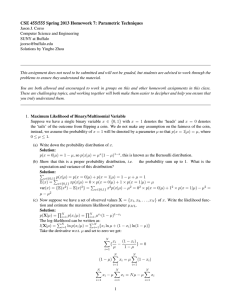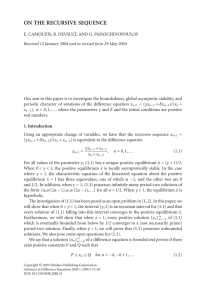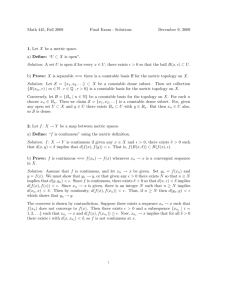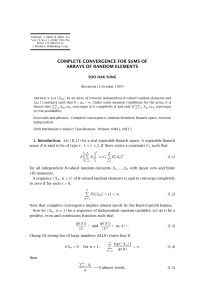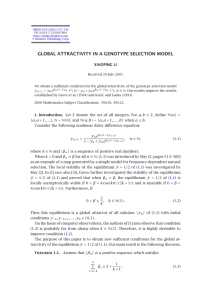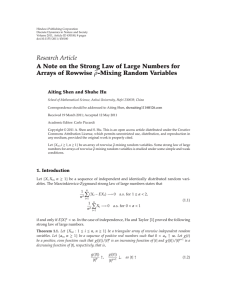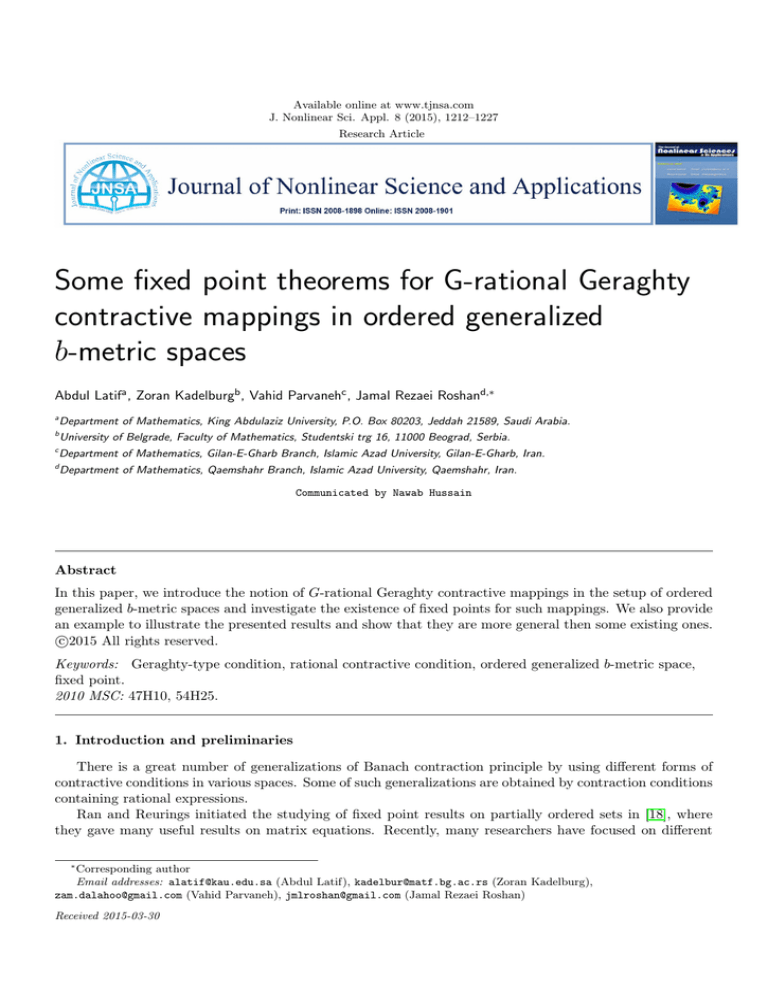
Available online at www.tjnsa.com
J. Nonlinear Sci. Appl. 8 (2015), 1212–1227
Research Article
Some fixed point theorems for G-rational Geraghty
contractive mappings in ordered generalized
b-metric spaces
Abdul Latifa , Zoran Kadelburgb , Vahid Parvanehc , Jamal Rezaei Roshand,∗
a
Department of Mathematics, King Abdulaziz University, P.O. Box 80203, Jeddah 21589, Saudi Arabia.
b
University of Belgrade, Faculty of Mathematics, Studentski trg 16, 11000 Beograd, Serbia.
c
Department of Mathematics, Gilan-E-Gharb Branch, Islamic Azad University, Gilan-E-Gharb, Iran.
d
Department of Mathematics, Qaemshahr Branch, Islamic Azad University, Qaemshahr, Iran.
Communicated by Nawab Hussain
Abstract
In this paper, we introduce the notion of G-rational Geraghty contractive mappings in the setup of ordered
generalized b-metric spaces and investigate the existence of fixed points for such mappings. We also provide
an example to illustrate the presented results and show that they are more general then some existing ones.
c
2015
All rights reserved.
Keywords: Geraghty-type condition, rational contractive condition, ordered generalized b-metric space,
fixed point.
2010 MSC: 47H10, 54H25.
1. Introduction and preliminaries
There is a great number of generalizations of Banach contraction principle by using different forms of
contractive conditions in various spaces. Some of such generalizations are obtained by contraction conditions
containing rational expressions.
Ran and Reurings initiated the studying of fixed point results on partially ordered sets in [18], where
they gave many useful results on matrix equations. Recently, many researchers have focused on different
∗
Corresponding author
Email addresses: alatif@kau.edu.sa (Abdul Latif), kadelbur@matf.bg.ac.rs (Zoran Kadelburg),
zam.dalahoo@gmail.com (Vahid Parvaneh), jmlroshan@gmail.com (Jamal Rezaei Roshan)
Received 2015-03-30
A. Latif, Z. Kadelburg, V. Parvaneh, J. R. Roshan, J. Nonlinear Sci. Appl. 8 (2015), 1212–1227
1213
contractive conditions in complete metric spaces endowed with a partial order and obtained many fixed point
results in such spaces. For more details on fixed point results, their applications, comparison of different
contractive conditions and related results in ordered metric spaces we refer the reader to [16, 17].
In [5], the authors proved some unique fixed point results for an operator satisfying certain rational
contraction condition in a partially ordered metric space. In fact, their results generalize the main result of
Jaggi [12].
Czerwik introduced in [7] the concept of a b-metric space. Since then, several papers dealt with fixed
point theory for single-valued and multi-valued operators in b-metric spaces.
Definition 1.1 ([7]). Let X be a nonempty set and s ≥ 1 be a given real number. A mapping d : X × X →
R+ is a b-metric if, for all x, y, z ∈ X, the following conditions are satisfied:
(b1 ) d(x, y) = 0 iff x = y,
(b2 ) d(x, y) = d(y, x),
(b3 ) d(x, z) ≤ s[d(x, y) + d(y, z)].
The pair (X, d) is called a b-metric space.
The concept of generalized metric space, or a G-metric space, was introduced by Mustafa and Sims.
Definition 1.2 ([14]). Let X be a nonempty set and G : X × X × X → R+ be a mapping satisfying the
following properties:
(G1) G(x, y, z) = 0 iff x = y = z;
(G2) 0 < G(x, x, y), for all x, y ∈ X with x 6= y;
(G3) G(x, x, y) ≤ G(x, y, z), for all x, y, z ∈ X with y 6= z;
(G4) G(x, y, z) = G(x, z, y) = G(y, z, x) = · · · , (symmetry in all three variables);
(G5) G(x, y, z) ≤ G(x, a, a) + G(a, y, z), for all x, y, z, a ∈ X (rectangle inequality).
Then, the function G is called a G-metric on X and the pair (X, G) is called a G-metric space.
References to the results in these two kinds of spaces can be found in [4]. Recently, Aghajani et al. in [1]
combined these two concepts and introduced the concept of generalized b-metric spaces (Gb -metric spaces)
and presented some of their basic properties.
Definition 1.3 ([1]). Let X be a nonempty set and s ≥ 1 be a given real number. Suppose that a mapping
G : X × X × X → R+ satisfies:
(Gb 1) G(x, y, z) = 0 if x = y = z,
(Gb 2) 0 < G(x, x, y) for all x, y ∈ X with x 6= y,
(Gb 3) G(x, x, y) ≤ G(x, y, z) for all x, y, z ∈ X with y 6= z,
(Gb 4) G(x, y, z) = G(p{x, y, z}), where p is a permutation of x, y, z (symmetry),
(Gb 5) G(x, y, z) ≤ s[G(x, a, a) + G(a, y, z)] for all x, y, z, a ∈ X (rectangle inequality).
Then G is called a generalized b-metric and the pair (X, G) is called a generalized b-metric space or a
Gb -metric space.
Each G-metric space is a Gb -metric space with s = 1.
Example 1.4 ([1]). Let (X, G) be a G-metric space and G∗ (x, y, z) = Gp (x, y, z), where p > 1 is a real
number. Then G∗ is a Gb -metric with s = 2p−1 .
A. Latif, Z. Kadelburg, V. Parvaneh, J. R. Roshan, J. Nonlinear Sci. Appl. 8 (2015), 1212–1227
1214
Example 1.5 ([15]). Let X = R and d(x, y) = |x − y|2 . We know that (X, d) is a b-metric space with
s = 2. Let G(x, y, z) = d(x, y) + d(y, z) + d(z, x). It is easy to see that (X, G) is not a Gb -metric space.
Indeed, (Gb 3) is not true for x = 0, y = 2 and z = 1. However, G(x, y, z) = max{d(x, y), d(y, z), d(z, x)} is
a Gb -metric on R with s = 2.
Various fixed point results in Gb -metric spaces were subsequently obtained in [11, 13, 15, 19]. See also
[2, 6, 20].
Definition 1.6 ([1, 14]). A Gb -metric G is said to be symmetric if G(x, y, y) = G(y, x, x), for all x, y ∈ X.
Proposition 1.7 ([1]). Let X be a Gb -metric space. Then for each x, y, z, a ∈ X it follows that:
(1) if G(x, y, z) = 0 then x = y = z,
(2) G(x, y, z) ≤ s(G(x, x, y) + G(x, x, z)),
(3) G(x, y, y) ≤ 2sG(y, x, x),
(4) G(x, y, z) ≤ s(G(x, a, z) + G(a, y, z)).
Definition 1.8 ([1]). Let (X, G) be a Gb -metric space. A sequence {xn } in X is said to be:
(1) Gb -Cauchy if, for each ε > 0, there exists a positive integer n0 such that for all m, n, l ≥ n0 ,
G(xn , xm , xl ) < ε;
(2) Gb -convergent to a point x ∈ X if, for each ε > 0, there exists a positive integer n0 such that for all
m, n ≥ n0 , G(xn , xm , x) < ε.
The space (X, G) is said to be Gb -complete if every Gb -Cauchy sequence is Gb -convergent in X.
Proposition 1.9 ([1]). Let (X, G) be a Gb -metric space and {xn } be a sequence in X. Then the following
are equivalent:
(1) the sequence {xn } is Gb -Cauchy.
(2) for any ε > 0 there exists n0 ∈ N such that G(xn , xm , xm ) < ε for all m, n ≥ n0 .
Also, the following are equivalent:
(3) {xn } is Gb -convergent to x.
(4) G(xn , xn , x) → 0, as n → ∞.
(5) G(xn , x, x) → 0, as n → ∞.
Definition 1.10. Let (X, G) be a Gb -metric space. A mapping F : X × X → X is said to be continuous
if for any two Gb -convergent sequences {xn } and {yn } converging to x and y, respectively, {F (xn , yn )} is
Gb -convergent to F (x, y).
Proposition 1.11 ([1]). Let (X, G) and (X 0 , G0 ) be two Gb -metric spaces. Then a function f : X → X 0 is
Gb -continuous at a point x ∈ X if and only if it is Gb -sequentially continuous at x, that is, whenever {xn }
is Gb -convergent to x, {f (xn )} is G0b -convergent to f (x).
In general, a Gb -metric function G(x, y, z) for s > 1 is not jointly continuous in all of its variables. The
following is an example of a discontinuous Gb -metric.
Example 1.12 ([10, 15]). Let X = N ∪ {∞} and let D : X × X → R be defined by
0,
if m = n,
1 − 1 , if one of m, n is even and the other is even or ∞,
m
n
D(m, n) =
5,
if one of m, n is odd and the other is odd (and m 6= n) or ∞,
2,
otherwise.
Then it is easy to see that for all m, n, p ∈ X, we have
5
D(m, p) ≤ (D(m, n) + D(n, p)).
2
A. Latif, Z. Kadelburg, V. Parvaneh, J. R. Roshan, J. Nonlinear Sci. Appl. 8 (2015), 1212–1227
Thus, (X, D) is a b-metric space with s = 52 (see [10]).
Let G(x, y, z) = max{D(x, y), D(y, z), D(z, x)}. It is easy to see that G is a Gb -metric with s =
is not a continuous function.
1215
5
2
which
We shall need the following simple lemma about the Gb -convergent sequences in the proof of our main
result.
Lemma 1.13 ([15]). Let (X, G) be a Gb -metric space with s > 1 and suppose that {xn }, {yn } and {zn } are
Gb -convergent to x, y and z, respectively. Then we have
1
G(x, y, z) ≤ lim inf G(xn , yn , zn ) ≤ lim sup G(xn , yn , zn ) ≤ s3 G(x, y, z).
n→∞
s3
n→∞
In particular, if x = y = z, then we have limn→∞ G(xn , yn , zn ) = 0.
Let F denote the class of all real functions β : [0, ∞) → [0, 1) satisfying the condition
β(tn ) → 1 implies that tn → 0, as n → ∞.
In order to generalize the Banach contraction principle, in 1973, Geraghty proved the following
Theorem 1.14 ([9]). Let (X, d) be a complete metric space, and let f : X → X be a self-map. Suppose that
there exists β ∈ F such that
d(f x, f y) ≤ β(d(x, y))d(x, y)
holds for all x, y ∈ X. Then f has a unique fixed point z ∈ X and for each x ∈ X the Picard sequence
{f n x} converges to z.
In 2010, Amini-Harandi and Emami extended the result of Geraghty to the framework of partially
ordered complete metric spaces in the following way:
Theorem 1.15 ([3]). Let (X, d, ) be a complete partially ordered metric space. Let f : X → X be an
increasing self-map such that there exists x0 ∈ X with x0 f x0 . Suppose that there exists β ∈ F such that
d(f x, f y) ≤ β(d(x, y))d(x, y)
holds for all x, y ∈ X with y x. Assume that either f is continuous or X is such that if an increasing
sequence {xn } in X converges to x ∈ X, then xn x for all n. Then f has a fixed point in X. Moreover,
if for each x, y ∈ X there exists z ∈ X comparable with x and y, then the fixed point of f is unique.
- ukić et al. proved some fixed point theorems for mappings satisfying Geraghty-type contractive
In [8], D
conditions in various generalized metric spaces. As in [8], we will consider the class of functions Fs , where
β ∈ Fs if β : [0, ∞) → [0, 1/s) and has the property
β(tn ) →
1
implies that tn → 0, as n → ∞.
s
Theorem 1.16 ([8]). Let (X, d) be a complete b-metric space with parameter s ≥ 1. Suppose that a mapping
f : X → X satisfies the condition
d(f x, f y) ≤ β(d(x, y))d(x, y)
for some β ∈ Fs and all x, y ∈ X. Then f has a unique fixed point z ∈ X, and for each x ∈ X the Picard
sequence {f n x} converges to z in (X, d).
By unification of the recent results by Zabihi and Razani there is the following result.
A. Latif, Z. Kadelburg, V. Parvaneh, J. R. Roshan, J. Nonlinear Sci. Appl. 8 (2015), 1212–1227
1216
Theorem 1.17 ([21]). Let (X, d, ) be a partially ordered b-complete b-metric space (with parameter s > 1).
Let f : X → X be an increasing mapping with respect to such that there exists an element x0 ∈ X with
x0 f (x0 ). Suppose that there exists β ∈ Fs such that
sd(f x, f y) ≤ β(d(x, y))M (x, y) + L N (x, y)
for all comparable elements x, y ∈ X, where L ≥ 0,
d(x, f x)d(y, f y)
M (x, y) = max d(x, y),
1 + d(f x, f y)
and
N (x, y) = min{d(x, f x), d(x, f y), d(y, f x), d(y, f y)}.
If f is continuous, or, whenever {xn } is a nondecreasing sequence in X such that xn → u ∈ X, one has
xn u for all n ∈ N, then f has a fixed point. Moreover, the set of fixed points of f is well ordered if and
only if f has one and only one fixed point.
The aim of this paper is to present some fixed point theorems for mappings in partially ordered Gb -metric
spaces satisfying several versions of rational Geraghty-type contractive conditions. Our results extend some
existing results in the literature. An example is presented showing the usefulness of these results and they
are indeed more general than some known ones.
2. Main results
Further, let Fs denote the class of all functions β : [0, ∞) → [0, 1s ) satisfying the following condition:
lim sup β(tn ) =
n→∞
1
implies that tn → 0, as n → ∞.
s
In the rest of the paper we shall always assume that the parameter s > 1. The case s = 1 (i.e., when we
deal with a G-metric space) can be handled easily.
Definition 2.1. Let (X, G, ) be an ordered Gb -metric space. A mapping f : X → X is called a G-rational
Geraghty contraction of type A if there exists β ∈ Fs such that
G(f x, f y, f z) ≤ β(MA (x, y, z))MA (x, y, z)
for all comparable elements x, y, z ∈ X, where
G(x, f x, f y)G(y, f y, f z)G(z, f z, f x)
MA (x, y, z) = max G(x, y, z),
,
1 + G(x, y, z)G(f x, f y, f z)
G(x, f x, f y)G(y, f y, f z)G(z, f z, f x)
.
1 + G2 (f x, f y, f z)
(2.1)
(2.2)
Theorem 2.2. Let (X, G, ) be an ordered Gb -complete Gb -metric space. Let f : X → X be an increasing
mapping with respect to such that there exists an element x0 ∈ X with x0 f x0 . Suppose that f is a
G-rational Geraghty contraction of type A. If
(I) f is continuous, or
(II) whenever {xn } is a nondecreasing sequence in X such that xn → u ∈ X, one has xn u for all n ∈ N,
then f has a fixed point. Moreover, the set of fixed points of f is well ordered if and only if f has one and
only one fixed point.
A. Latif, Z. Kadelburg, V. Parvaneh, J. R. Roshan, J. Nonlinear Sci. Appl. 8 (2015), 1212–1227
1217
Proof. Put xn = f n x0 . Since x0 f x0 and f is increasing, we obtain by induction that
x0 f x0 f 2 x0 · · · f n x0 f n+1 x0 · · · .
We will do the proof in the following steps.
Step 1. We will show that lim G(xn , xn+1 , xn+1 ) = 0. Without any loss of generality, we may assume
n→∞
that xn 6= xn+1 , for all n ∈ N. Since xn xn+1 for each n ∈ N, then by (2.1) we have
G(xn , xn+1 , xn+2 ) = G(f xn−1 , f xn , f xn+1 ) ≤ β(MA (xn−1 , xn , xn+1 ))MA (xn−1 , xn , xn+1 ),
(2.3)
where
MA (xn−1 , xn , xn+1 )
G(xn−1 , f xn−1 , f xn )G(xn , f xn , f xn+1 )G(xn+1 , f xn+1 , f xn−1 )
= max G(xn−1 , xn , xn+1 ),
,
1 + G(xn−1 , xn , xn+1 )G(f xn−1 , f xn , f xn+1 )
G(xn−1 , f xn−1 , f xn )G(xn , f xn , f xn+1 )G(xn+1 , f xn+1 , f xn−1 )
1 + G2 (f xn−1 , f xn , f xn+1 )
G(xn−1 , xn , xn+1 )G(xn , xn+1 , xn+2 )G(xn+1 , xn+2 , xn )
= max G(xn−1 , xn , xn+1 ),
,
1 + G(xn−1 , xn , xn+1 )G(xn , xn+1 , xn+2 )
G(xn−1 , xn , xn+1 )G(xn , xn+1 , xn+2 )G(xn+1 , xn+2 , xn )
1 + G2 (xn , xn+1 , xn+2 )
≤ max {G(xn−1 , xn , xn+1 ), G(xn , xn+1 , xn+2 )} .
If max{G(xn−1 , xn , xn+1 ), G(xn , xn+1 , xn+2 )} = G(xn , xn+1 , xn+2 ), then from (2.3) we have
G(xn , xn+1 , xn+2 ) ≤ β(MA (xn−1 , xn , xn+1 ))G(xn , xn+1 , xn+2 )
1
< G(xn , xn+1 , xn+2 )
s
< G(xn , xn+1 , xn+2 ),
which is a contradiction. Hence, max{G(xn−1 , xn , xn+1 ), G(xn , xn+1 , xn+2 )} = G(xn−1 , xn , xn+1 ). So, from
(2.3),
1
G(xn , xn+1 , xn+2 ) ≤ β(MA (xn−1 , xn , xn+1 ))G(xn−1 , xn , xn+1 ) < G(xn−1 , xn , xn+1 ).
s
Continuing by induction, we get that
1
G(xn , xn+1 , xn+2 ) < n G(x0 , x1 , x2 ) → 0 as n → ∞.
s
Hence, limn→∞ G(xn , xn+1 , xn+2 ) = 0. Consequently, using (Gb 3), we get that
lim G(xn , xn+1 , xn+1 ) = 0.
n→∞
(2.4)
Step 2. Now, we prove that the sequence {xn } is a Gb -Cauchy sequence. Suppose the contrary. Then
there exists ε > 0 for which we can find two subsequences {xmi } and {xni } of {xn } such that ni is the
smallest index for which
ni > mi > i and G(xmi , xni , xni ) ≥ ε.
(2.5)
This means that
G(xmi , xni −1 , xni −1 ) < ε.
From the rectangular inequality, we get
ε ≤ G(xmi , xni , xni ) ≤ sG(xmi , xmi +1 , xmi +1 ) + sG(xmi +1 , xni , xni ).
By taking the upper limit as i → ∞ and by (2.4), we get
ε
≤ lim sup G(xmi +1 , xni , xni ).
s
i→∞
From the definition of MA (x, y, z) and the above limits,
A. Latif, Z. Kadelburg, V. Parvaneh, J. R. Roshan, J. Nonlinear Sci. Appl. 8 (2015), 1212–1227
1218
lim sup MA (xmi ,xni −1 , xni −1 )
i→∞
= lim sup max{G(xmi , xni −1 , xni −1 ),
i→∞
G(xmi , f xmi , f xni −1 )G(xni −1 , f xni −1 , f xni −1 )G(xni −1 , f xni −1 , f xmi )
,
1 + G(xmi , xni −1 , xni −1 )G(f xmi , f xni −1 , f xni −1 )
G(xmi , f xmi , f xni −1 )G(xni −1 , f xni −1 , f xni −1 )G(xni −1 , f xni −1 , f xmi )
}
1 + G2 (f xmi , f xni −1 , f xni −1 )
= lim sup max{G(xmi , xni −1 , xni −1 ),
i→∞
G(xmi , xmi +1 , xni )G(xni −1 , xni , xni )G(xni −1 , xni , xmi +1 )
,
1 + G(xmi , xni −1 , xni −1 )G(xmi +1 , xni , xni )
G(xmi , xmi +1 , xni )G(xni −1 , xni , xni )G(xni −1 , xni , xmi +1 )
}
1 + G2 (xmi +1 , xni , xni )
≤ ε.
Now, from (2.1) and the above inequalities, we have
ε
≤ lim sup G(xmi +1 , xni , xni )
s
i→∞
≤ lim sup β(MA (xmi , xni −1 , xni −1 )) lim sup MA (xmi , xni −1 , xni −1 )
i→∞
i→∞
≤ ε lim sup β(MA (xmi , xni −1 , xni −1 ))
i→∞
which implies that
1
s
≤ lim sup β(MA (xmi , xni −1 , xni −1 )).
Now, as β ∈ Fs we conclude that
i→∞
MA (xmi , xni −1 , xni −1 ) → 0 which yields that G(xmi , xni −1 , xni −1 ) → 0. Consequently,
G(xmi , xni , xni ) ≤ sG(xmi , xni −1 , xni −1 ) + sG(xni −1 , xni , xni ) → 0,
a contradiction to (2.5). Therefore, {xn } is a Gb -Cauchy sequence. Gb -completeness of X yields that {xn }
Gb -converges to a point u ∈ X.
Step 3. u is a fixed point of f .
First of all, if f is continuous, then we have
u = lim xn+1 = lim f xn = f u.
n→∞
n→∞
Now, let (II) hold. Using the assumption on X we have xn u for n ∈ N. Now, we show that u = f u.
By Lemma 1.13,
1
G(u, u, f u) ≤ lim sup G(xn+1 , xn+1 , f u)
s3
n→∞
≤ lim sup β(MA (xn , xn , u)) lim sup MA (xn , xn , u),
n→∞
n→∞
where
G(xn , f xn , f xn )G(xn , f xn , f u)G(u, f u, f xn )
,
1 + G(xn , xn , u)G(f xn , f xn , f u)
G(xn , f xn , f xn )G(xn , f xn , f u)G(u, f u, f xn )
} = 0.
1 + G2 (f xn , f xn , f u)
lim MA (xn , xn , u) = lim max{G(xn , xn , u),
n→∞
n→∞
Therefore, we deduce that G(u, u, f u) = 0, so u = f u.
A. Latif, Z. Kadelburg, V. Parvaneh, J. R. Roshan, J. Nonlinear Sci. Appl. 8 (2015), 1212–1227
1219
Finally, suppose that the set of fixed points of f is well ordered. Assume, to the contrary, that u and v
are two distinct fixed points of f . Then by (2.1), we have
1
G(u, v, v) = G(f u, f v, f v) ≤ β(MA (u, v, v))MA (u, v, v) = β(G(u, v, v))G(u, v, v) < G(u, v, v),
s
because
G(u, u, v)G(v, v, v)G(v, v, u)
MA (u, v, v) = max G(u, v, v),
1 + G2 (u, v, v)
(2.6)
= G(u, v, v).
So, we get G(u, v, v) < 1s G(u, v, v), a contradiction. Hence u = v, and f has a unique fixed point. Conversely,
if f has a unique fixed point, then the set of fixed points of f is a singleton and so it is well ordered.
Definition 2.3. Let (X, G, ) be an ordered Gb -metric space. A mapping f : X → X is called a G-rational
Geraghty contraction of type B if, there exists β ∈ Fs such that,
G(f x, f y, f z) ≤ β(MB (x, y, z))MB (x, y, z)
(2.7)
for all comparable elements x, y, z ∈ X, where
MB (x, y, z)
G(x, x, f x)G(x, x, f y) + G(y, y, f y)G(y, y, f x)
,
= max G(x, y, z),
1 + s[G(x, x, f x) + G(y, y, f y)]
G(y, y, f y)G(y, y, f z) + G(z, z, f z)G(z, z, f y) G(x, x, f x)G(x, x, f y) + G(y, y, f y)G(y, y, f x)
,
,
1 + s[G(y, y, f y) + G(z, z, f z)]
1 + G(x, x, f y) + G(y, y, f x)
G(y, y, f y)G(y, y, f z) + G(z, z, f z)G(z, z, f y)
.
(2.8)
1 + G(y, y, f z) + G(z, z, f y)
Theorem 2.4. Let (X, G, ) be an ordered Gb -complete Gb -metric space. Let f : X → X be an increasing
mapping with respect to such that there exists an element x0 ∈ X with x0 f x0 . Suppose that f is a
G-rational Geraghty contractive mapping of type B. If
(I) f is continuous, or
(II) whenever {xn } is a nondecreasing sequence in X such that xn → u ∈ X, one has xn u for all n ∈ N,
then f has a fixed point. Moreover, the set of fixed points of f is well ordered if and only if f has one and
only one fixed point.
Proof. Put xn = f n x0 . Since x0 f x0 and f is an increasing function, we obtain by induction that
x0 f x0 f 2 x0 · · · f n x0 f n+1 x0 · · · .
We will make the proof in the following steps.
Step I: We will show that lim G(xn , xn+1 , xn+1 ) = 0. Without any loss of generality, we may assume
n→∞
that xn 6= xn+1 , for all n ∈ N. Since xn xn+1 for each n ∈ N, then by (2.7) we have
G(xn , xn+1 , xn+2 ) = G(f xn−1 , f xn , f xn+1 ) ≤ β(MB (xn−1 , xn , xn+1 ))MB (xn−1 , xn , xn+1 )
1
≤ β(MB (xn−1 , xn , xn+1 ))G(xn−1 , xn , xn+1 ) < G(xn−1 , xn , xn+1 ),
s
because
MB (xn−1 , xn , xn+1 ) = max{G(xn−1 , xn , xn+1 ),
G(xn−1 , xn−1 , f xn−1 )G(xn−1 , xn−1 , f xn ) + G(xn , xn , f xn )G(xn , xn , f xn−1 )
,
1 + s[G(xn−1 , xn−1 , f xn−1 ) + G(xn , xn , f xn )]
(2.9)
A. Latif, Z. Kadelburg, V. Parvaneh, J. R. Roshan, J. Nonlinear Sci. Appl. 8 (2015), 1212–1227
1220
G(xn , xn , f xn )G(xn , xn , f xn+1 ) + G(xn+1 , xn+1 , f xn+1 )G(xn+1 , xn+1 , f xn )
,
1 + s[G(xn , xn , f xn ) + G(xn+1 , xn+1 , f xn+1 )]
G(xn−1 , xn−1 , f xn−1 )G(xn−1 , xn−1 , f xn ) + G(xn , xn , f xn )G(xn , xn , f xn−1 )
,
1 + G(xn−1 , xn−1 , f xn ) + G(xn , xn , f xn−1 )
G(xn , xn , f xn )G(xn , xn , f xn+1 ) + G(xn+1 , xn+1 , f xn+1 )G(xn+1 , xn+1 , f xn )
}
1 + G(xn , xn , f xn+1 ) + G(xn+1 , xn+1 , f xn )
= max{G(xn−1 , xn , xn+1 ),
G(xn−1 , xn−1 , xn )G(xn−1 , xn−1 , xn+1 ) + G(xn , xn , xn+1 )G(xn , xn , xn )
,
1 + s[G(xn−1 , xn−1 , xn ) + G(xn , xn , xn+1 )]
G(xn , xn , xn+1 )G(xn , xn , xn+2 ) + G(xn+1 , xn+1 , xn+2 )G(xn+1 , xn+1 , xn+1 )
,
1 + s[G(xn , xn , xn+1 ) + G(xn+1 , xn+1 , xn+2 )]
G(xn−1 , xn−1 , xn )G(xn−1 , xn−1 , xn+1 ) + G(xn , xn , xn+1 )G(xn , xn , xn )
,
1 + G(xn−1 , xn−1 , xn+1 ) + G(xn , xn , xn )
G(xn , xn , xn+1 )G(xn , xn , xn+2 ) + G(xn+1 , xn+1 , xn+2 )G(xn+1 , xn+1 , xn+1 )
}
1 + G(xn , xn , xn+2 ) + G(xn+1 , xn+1 , xn+1 )
≤ max{G(xn−1 , xn , xn+1 ),
G(xn−1 , xn−1 , xn )s[G(xn−1 , xn−1 , xn ) + G(xn , xn , xn+1 )]
,
1 + s[G(xn−1 , xn−1 , xn ) + G(xn , xn , xn+1 )]
G(xn , xn , xn+1 )s[G(xn , xn , xn+1 ) + G(xn+1 , xn+1 , xn+2 )]
,
1 + s[G(xn , xn , xn+1 ) + G(xn+1 , xn+1 , xn+2 )]
G(xn−1 , xn−1 , xn )G(xn−1 , xn−1 , xn+1 )
,
1 + G(xn−1 , xn−1 , xn+1 ) + G(xn , xn , xn )
G(xn , xn , xn+1 )G(xn , xn , xn+2 )
}
1 + G(xn , xn , xn+2 ) + G(xn+1 , xn+1 , xn+1 )
≤ max{G(xn−1 , xn , xn+1 ), G(xn−1 , xn−1 , xn ), G(xn , xn , xn+1 )}
≤ max{G(xn−1 , xn , xn+1 ), G(xn , xn+1 , xn+2 )},
and it is easy to see that max{G(xn−1 , xn , xn+1 ), G(xn , xn+1 , xn+2 )} = G(xn−1 , xn , xn+1 ). Hence, in the
same way as in the proof of the preceding theorem, we obtain from (2.9) that
lim G(xn , xn+1 , xn+1 ) = 0
n→∞
is true.
Step 2. Now, we prove that the sequence {xn } is a Gb -Cauchy sequence. Suppose the contrary. Then
there exists ε > 0 for which we can find two subsequences {xmi } and {xni } of {xn } such that ni is the
smallest index for which
ni > mi > i and G(xmi , xni , xni ) ≥ ε.
This means that
G(xmi , xni −1 , xni −1 ) < ε.
As in the proof of Theorem 2.2, we have,
ε
≤ lim sup G(xmi +1 , xni , xni ).
s
i→∞
From the definition of MB (x, y, z) and the above limits,
A. Latif, Z. Kadelburg, V. Parvaneh, J. R. Roshan, J. Nonlinear Sci. Appl. 8 (2015), 1212–1227
1221
lim sup MB (xmi , xni −1 , xni −1 )
i→∞
= lim sup max{G(xmi , xni −1 , xni −1 ),
i→∞
G(xmi , xmi , f xmi )G(xmi , xmi , f xni −1 ) + G(xni −1 , xni −1 , f xni −1 )G(xni −1 , xni −1 , f xmi )
,
1 + s[G(xmi , xmi , f xmi ) + G(xni −1 , xni −1 , f xni −1 )]
G(xni −1 , xni −1 , f xni −1 )G(xni −1 , xni −1 , f xni −1 ) + G(xni −1 , xni −1 , f xni −1 )G(xni −1 , xni −1 , f xni −1 )
,
1 + s[G(xni −1 , xni −1 , f xni −1 ) + G(xni −1 , xni −1 , f xni −1 )]
G(xmi , xmi , f xmi )G(xmi , xmi , f xni −1 ) + G(xni −1 , xni −1 , f xni −1 )G(xni −1 , xni −1 , f xmi )
,
1 + G(xmi , xmi , f xni −1 ) + G(xni −1 , xni −1 , f xmi )
G(xni −1 , xni −1 , f xni −1 )G(xni −1 , xni −1 , f xni −1 ) + G(xni −1 , xni −1 , f xni −1 )G(xni −1 , xni −1 , f xni −1 ) o
1 + G(xni −1 , xni −1 , f xni −1 ) + G(xni −1 , xni −1 , f xni −1 )
≤ ε.
Now, from (2.7) and the above inequalities, we have
ε
≤ lim sup G(xmi +1 , xni , xni )
s
i→∞
≤ lim sup β(MB (xmi , xni −1 , xni −1 )) lim sup MB (xmi , xni −1 , xni −1 )
i→∞
i→∞
≤ ε lim sup β(MB (xmi , xni −1 , xni −1 ))
i→∞
which implies that
1
s
≤ lim sup β(MB (xmi , xni −1 , xni −1 )). Now, as β ∈ Fs we conclude that {xn } is a
i→∞
Gb -Cauchy sequence. Gb -completeness of X yields that {xn } Gb -converges to a point u ∈ X.
Step 3. u is a fixed point of f . This step is proved in the same way as Step 3 of Theorem 2.2.
Definition 2.5. Let (X, G, ) be an ordered Gb -metric space. A mapping f : X → X is called a G-rational
Geraghty contraction of type C if there exists β ∈ Fs such that,
2s3 G(f x, f y, f z) ≤ β(MC (x, y, z))MC (x, y, z)
(2.10)
for all comparable elements x, y, z ∈ X, where
MC (x, y, z) = max G(x, y, z),
G(x, x, f x)G(y, y, f y)
,
1 + s[G(x, y, y) + G(x, x, f y) + G(y, y, f x)]
G(x, y, y)G(x, x, y)
,
1 + G(x, f x, f x) + G(y, y, f x) + G(y, f y, f y)
G(y, y, f y)G(z, z, f z)
,
1 + s[G(y, z, z) + G(y, y, f z) + G(z, z, f y)]
G(y, z, z)G(y, y, z)
.
1 + G(y, f y, f y) + G(z, z, f y) + G(z, f z, f z)
(2.11)
Theorem 2.6. Let (X, G, ) be an ordered Gb -complete Gb -metric space. Let f : X → X be an increasing
mapping with respect to such that there exists an element x0 ∈ X with x0 f x0 . Suppose that f is a
G-rational Geraghty contractive mapping of type C. If
(I) f is continuous, or,
(II) whenever {xn } is a nondecreasing sequence in X such that xn → u ∈ X, one has xn u for all n ∈ N,
then f has a fixed point. Moreover, the set of fixed points of f is well ordered if and only if f has one and
only one fixed point.
Proof. Put xn = f n x0 .
Step 1. We will show that lim G(xn , xn+1 , xn+1 ) = 0. Without loss of generality, we may assume that
n→∞
xn 6= xn+1 , for all n ∈ N. Since xn xn+1 for each n ∈ N, then by (2.10) we have
A. Latif, Z. Kadelburg, V. Parvaneh, J. R. Roshan, J. Nonlinear Sci. Appl. 8 (2015), 1212–1227
1222
G(xn , xn+1 , xn+2 ) ≤ 2s3 G(xn , xn+1 , xn+2 ) = 2s3 G(f xn−1 , f xn , f xn+1 )
≤ β(MC (xn−1 , xn , xn+1 ))MC (xn−1 , xn , xn+1 )
≤ β(MC (xn−1 , xn , xn+1 ))G(xn−1 , xn , xn+1 )
1
< G(xn−1 , xn , xn+1 ),
s
because
MC (xn−1 , xn , xn+1 )
= max{G(xn−1 , xn , xn+1 ),
G(xn−1 , xn−1 , f xn−1 )G(xn , xn , f xn )
,
1 + s[G(xn−1 , xn , xn ) + G(xn−1 , xn−1 , f xn ) + G(xn , xn , f xn−1 )]
G(xn−1 , xn , xn )G(xn−1 , xn−1 , xn )
,
1 + G(xn−1 , f xn−1 , f xn−1 ) + G(xn , xn , f xn−1 ) + G(xn , f xn , f xn )
G(xn , xn , f xn )G(xn+1 , xn+1 , f xn+1 )
,
1 + s[G(xn , xn+1 , xn+1 ) + G(xn , xn , f xn+1 ) + G(xn+1 , xn+1 , f xn )]
o
G(xn , xn+1 , xn+1 )G(xn , xn , xn+1 )
1 + G(xn , f xn , f xn ) + G(xn+1 , xn+1 , f xn ) + G(xn+1 , f xn+1 , f xn+1 )
= max{G(xn−1 , xn , xn+1 ),
G(xn−1 , xn−1 , xn )G(xn , xn , xn+1 )
,
1 + s[G(xn−1 , xn , xn ) + G(xn−1 , xn−1 , xn+1 ) + G(xn , xn , xn )]
G(xn−1 , xn , xn )G(xn−1 , xn−1 , xn )
,
1 + G(xn−1 , xn , xn ) + G(xn , xn , xn ) + G(xn , xn+1 , xn+1 )
G(xn , xn , xn+1 )G(xn+1 , xn+1 , xn+2 )
,
1 + s[G(xn , xn+1 , xn+1 ) + G(xn , xn , xn+2 ) + G(xn+1 , xn+1 , xn+1 )]
o
G(xn , xn+1 , xn+1 )G(xn , xn , xn+1 )
1 + G(xn , xn+1 , xn+1 ) + G(xn+1 , xn+1 , xn+1 ) + G(xn+1 , xn+2 , xn+2 )
≤ max{G(xn−1 , xn , xn+1 ),
G(xn−1 , xn−1 , xn )s[G(xn , xn , xn−1 ) + G(xn−1 , xn−1 , xn+1 )]
,
1 + s[G(xn−1 , xn , xn ) + G(xn−1 , xn−1 , xn+1 )]
G(xn−1 , xn , xn )G(xn−1 , xn−1 , xn )
,
1 + G(xn−1 , xn , xn ) + G(xn , xn+1 , xn+1 )
G(xn , xn , xn+1 )s[G(xn+1 , xn+1 , xn ) + G(xn , xn , xn+2 )]
,
1 + s[G(xn , xn+1 , xn+1 ) + G(xn , xn , xn+2 )]
o
G(xn , xn+1 , xn+1 )G(xn , xn , xn+1 )
1 + G(xn , xn+1 , xn+1 ) + G(xn+1 , xn+2 , xn+2 )
≤ max{G(xn−1 , xn , xn+1 ), G(xn−1 , xn−1 , xn ), G(xn , xn , xn+1 )}
≤ max{G(xn−1 , xn , xn+1 ), G(xn , xn+1 , xn+2 )}
and it is again easy to see that max{G(xn−1 , xn , xn+1 ), G(xn , xn+1 , xn+2 )} = G(xn−1 , xn , xn+1 ). Hence, in
the same way as in the proof of Theorems 2.2 and 2.4, we obtain that
lim G(xn , xn+1 , xn+1 ) = 0
n→∞
(2.12)
is true.
Step 2. Now, we prove that the sequence {xn } is a Gb -Cauchy sequence. Suppose the contrary. Then
there exists ε > 0 for which we can find two subsequences {xmi } and {xni } of {xn } such that ni is the
A. Latif, Z. Kadelburg, V. Parvaneh, J. R. Roshan, J. Nonlinear Sci. Appl. 8 (2015), 1212–1227
1223
smallest index for which
ni > mi > i and G(xmi , xni , xni ) ≥ ε.
This means that
G(xmi , xni −1 , xni −1 ) < ε.
Hence,
G(xmi , xmi , xni −1 ) < 2sε.
From the rectangular inequality, we get
ε ≤ G(xmi , xni , xni ) ≤ sG(xmi , xmi +1 , xmi +1 ) + sG(xmi +1 , xni , xni ).
By taking the upper limit as i → ∞, we get
ε
≤ lim sup G(xmi +1 , xni , xni ).
s
i→∞
From (2.12) and using the rectangular inequality, we get
ε ≤ G(xmi , xni , xni ) ≤ sG(xmi , xmi +1 , xmi +1 ) + sG(xmi +1 , xni , xni )
≤ sG(xmi , xmi +1 , xmi +1 ) + s2 G(xmi +1 , xni −1 , xni −1 ) + s2 G(xni −1 , xni , xni ).
By taking the upper limit as i → ∞, we get
ε
≤ lim sup G(xmi +1 , xni −1 , xni −1 ).
s2
i→∞
From the definition of MC (x, y, z) and the above limits,
lim supMC (xmi , xni −1 , xni −1 )
i→∞
= lim sup max{G(xmi , xni −1 , xni −1 ),
i→∞
G(xmi , xmi , f xmi )G(xni −1 , xni −1 , f xni −1 )
,
1 + s[G(xmi , xni −1 , xni −1 ) + G(xmi , xmi , f xni −1 ) + G(xni −1 , xni −1 , f xmi )]
G(xmi , xni −1 , xni −1 )G(xmi , xmi , xni −1 )
,
1 + G(xmi , f xmi , f xmi ) + G(xni −1 , xni −1 , f xmi ) + G(xni −1 , f xni −1 , f xni −1 )
G(xni −1 , xni −1 , f xni −1 )G(xni −1 , xni −1 , f xni −1 )
,
1 + s[G(xni −1 , xni −1 , xni −1 ) + G(xni −1 , xni −1 , f xni −1 ) + G(xni −1 , xni −1 , f xni −1 )]
o
G(xni −1 , xni −1 , xni −1 )G(xni −1 , xni −1 , xni −1 )
1 + G(xni −1 , f xni −1 , f xni −1 ) + G(xni −1 , xni −1 , f xni −1 ) + G(xni −1 , f xni −1 , f xni −1 )
s2
≤ ε · 2sε ·
= 2s3 ε.
ε
Now, from (2.10) and the above inequalities, we have
ε
2s3 · ≤ 2s3 · lim sup G(xmi +1 , xni , xni )
s
i→∞
≤ lim sup β(MC (xmi , xni −1 , xni )) lim sup MC (xmi , xni −1 , xni )
i→∞
3
i→∞
≤ 2s ε lim sup β(MC (xmi , xni −1 , xni −1 ))
i→∞
which implies that
1
s
≤ lim sup β(MC (xmi , xni −1 , xni −1 )). Now, as β ∈ Fs we conclude that {xn } is a
i→∞
Gb -Cauchy sequence. Gb -completeness of X yields that {xn } Gb -converges to a point u ∈ X.
Step 3. u is a fixed point of f .
When f is continuous, the proof is straightforward. Now, let (II) hold. We omit the proof as it is similar
to the proof of Step 3 of Theorem 2.2.
A. Latif, Z. Kadelburg, V. Parvaneh, J. R. Roshan, J. Nonlinear Sci. Appl. 8 (2015), 1212–1227
1224
If in the above theorems we take β(t) = r, where 0 ≤ r < 1s , then we have the following corollary.
Corollary 2.7. Let (X, G, ) be a partially ordered Gb -complete Gb -metric space, and let f : X → X be an
increasing mapping with respect to such that there exists an element x0 ∈ X with x0 f x0 . Suppose that
G(f x, f y, f z) ≤ rM (x, y, z)
for all comparable elements x, y, z ∈ X, where
M (x, y, z) = MA (x, y, z) or M (x, y, z) = MB (x, y, z)
(see (2.2), (2.8)), or
2s3 G(f x, f y, f z) ≤ rMC (x, y, z)
(see (2.11)). If f is continuous, or, for any nondecreasing sequence {xn } in X such that xn → u ∈ X one
has xn u for all n ∈ N , then f has a fixed point.
The following corollaries can also be easily deduced from the proved theorems.
Corollary 2.8. Let (X, G, ) be a partially ordered Gb -complete Gb -metric space, and let f : X → X be an
increasing mapping with respect to such that there exists an element x0 ∈ X with x0 f x0 . Suppose that
G(x, f x, f y)G(y, f y, f z)G(z, f z, f x)
1 + G(x, y, z)G(f x, f y, f z)
G(x, f x, f y)G(y, f y, f z)G(z, f z, f x)
,
+γ
1 + G2 (f x, f y, f z)
G(f x, f y, f z) ≤ αG(x, y, z) + β
or
G(x, x, f x)G(x, x, f y) + G(y, y, f y)G(y, y, f x)
1 + s[G(x, x, f x) + G(y, y, f y)]
G(y, y, f y)G(y, y, f z) + G(z, z, f z)G(z, z, f y)
+c
1 + s[G(y, y, f y) + G(z, z, f z)]
G(x, x, f x)G(x, x, f y) + G(y, y, f y)G(y, y, f x)
+d
1 + G(x, x, f y) + G(y, y, f x)
G(y, y, f y)G(y, y, f z) + G(z, z, f z)G(z, z, f y)
+e
,
1 + G(y, y, f z) + G(z, z, f y)
G(f x, f y, f z) ≤ aG(x, y, z) + b
or
G(x, x, f x)G(y, y, f y)
1 + s[G(x, y, y) + G(x, x, f y) + G(y, y, f x)]
G(x, y, y)G(x, x, y)
+c
1 + G(x, f x, f x) + G(y, y, f x) + G(y, f y, f y)
G(y, y, f y)G(z, z, f z)
+d
1 + s[G(y, z, z) + G(y, y, f z) + G(z, z, f y)]
G(y, z, z)G(y, y, z)
+e
,
1 + G(y, f y, f y) + G(z, z, f y) + G(z, f z, f z)
2s3 G(f x, f y, f z) ≤ aG(x, y, z) + b
for all comparable elements x, y, z ∈ X, where α, β, γ, a, b, c, d, e ≥ 0 and 0 ≤ α + β + γ < 1s and
0 ≤ a + b + c + d + e < 1s .
If f is continuous, or, for any nondecreasing sequence {xn } in X such that xn → u ∈ X one has xn u
for all n ∈ N , then f has a fixed point.
A. Latif, Z. Kadelburg, V. Parvaneh, J. R. Roshan, J. Nonlinear Sci. Appl. 8 (2015), 1212–1227
1225
Corollary 2.9. Let (X, G, ) be a partially ordered Gb -complete Gb -metric space, and let f : X → X be an
increasing mapping with respect to such that there exists an element x0 ∈ X with x0 f m x0 and
G(f m x, f m y, f m z) ≤ β(M (x, y, z))M (x, y, z)
for all comparable elements x, y, z ∈ X, where
G(x, f m x, f m y)G(y, f m y, f m z)G(z, f m z, f m x)
M (x, y, z) = max G(x, y, z),
,
1 + G(x, y, z)G(f m x, f m y, f m z)
G(x, f m x, f m y)G(y, f m y, f m z)G(z, f m z, f m x)
,
1 + G2 (f m x, f m y, f m z)
or
M (x, y, z)
G(x, x, f m x)G(x, x, f m y) + G(y, y, f m y)G(y, y, f m x)
= max G(x, y, z),
,
1 + s[G(x, x, f m x) + G(y, y, f m y)]
G(y, y, f m y)G(y, y, f m z) + G(z, z, f m z)G(z, z, f m y)
,
1 + s[G(y, y, f m y) + G(z, z, f m z)]
G(x, x, f m x)G(x, x, f m y) + G(y, y, f m y)G(y, y, f m x)
,
1 + G(x, x, f m y) + G(y, y, f m x)
G(y, y, f m y)G(y, y, f m z) + G(z, z, f m z)G(z, z, f m y)
,
1 + G(y, y, f m z) + G(z, z, f m y)
or
2s3 G(f m x, f m y, f m z) ≤ β(M (x, y, z))M (x, y, z),
where
G(x, x, f m x)G(y, y, f m y)
,
1 + s[G(x, y, y) + G(x, x, f m y) + G(y, y, f m x)]
G(x, y, y)G(x, x, y)
,
1 + G(x, f m x, f m x) + G(y, y, f m x) + G(y, f m y, f m y)
G(y, y, f m y)G(z, z, f m z)
,
1 + s[G(y, z, z) + G(y, y, f m z) + G(z, z, f m y)]
G(y, z, z)G(y, y, z)
.
1 + G(y, f m y, f m y) + G(z, z, f m y) + G(z, f m z, f m z)
M (x, y, z) = max G(x, y, z),
for some positive integer m.
If f m is continuous, or, for any nondecreasing sequence {xn } in X such that xn → u ∈ X one has
xn u for all n ∈ N , then f has a fixed point.
We illustrate a possible usage of Theorem 2.2 by the following example. It is clear that similar examples
can be constructed for Theorems 2.4 and 2.6.
Example 2.10. Let X = {a, b, c} and
0,
G(x, y, z) = 1,
4,
G : X 3 → R+ be given as
if x = y = z,
if (x, y, z) ∈ {(a, a, b), (a, b, b), (a, c, c), (b, c, c)},
if (x, y, z) ∈ {(a, a, c), (b, b, c), (a, b, c)},
and extended by symmetry. Then it is easy to check that X is a Gb -metric space, with s = 2, which is
asymmetric since, e.g., G(a, a, c) 6= G(a, c, c) (this is important, since it is well-known that the results in
A. Latif, Z. Kadelburg, V. Parvaneh, J. R. Roshan, J. Nonlinear Sci. Appl. 8 (2015), 1212–1227
1226
symmetric G-metric (Gb -metric) spaces can usually be easily reduced to their standard metric (b-metric)
counterparts). Define a reflexive and transitive order relation on X by c b a and a mapping
f : X → X by
a b c
f=
.
a a b
Then f is increasing, c f c and the space (X, G, ) is Gb -complete. We will show that the contractive
condition (2.1) of Theorem 2.2 is fulfilled with β ∈ Fs given by
1
β(t) = e−t/8 for t ∈ (0, ∞) and β(0) ∈ [0, 1/2).
2
Consider the following possible cases.
1. If x = y = z or x, y, z ∈ {a, b}, then G(f x, f y, f z) = 0 and inequality (2.1) is trivial.
In all other cases G(f x, f y, f z) = 1.
2. If (x, y, z) ∈ {(a, a, c), (b, b, c), (a, b, c), . . . } (. . . stays for permutations), then MA (x, y, z) = G(x, y, z) =
4. Thus, (2.1) is satisfied since it reduces to
1
1 ≤ e−4/8 · 4, i.e., e1/2 ≤ 2.
2
3. If (x, y, z) ∈ {(a, c, c), (b, c, c), . . . } (. . . stays for permutations), then it is easy to check that
MA (x, y, z) = 8. Thus, (2.1) is again satisfied since it reduces to
1
1 ≤ e−8/8 · 8, i.e., e ≤ 4.
2
All the assumptions of Theorem 2.2 are fulfilled and f has a unique fixed point (equal to a).
Note that simple non-rational Geraghty-type condition
G(f x, f y, f z) ≤ β(G(x, y, z))G(x, y, z)
is not satisfied. Indeed, e.g., for (x, y, z) = (a, c, c) it reduces to 1 ≤ 12 e−1/8 · 1 and does not hold.
Acknowledgements:
This article was funded by the Deanship of Scientific Research (DSR), King Abdulaziz University, Jeddah.
Therefore the first author, acknowledges with thanks the DSR for the technical and financial support.
References
[1] A. Aghajani, M. Abbas, J. R. Roshan, Common fixed point of generalized weak contractive mappings in partially
ordered Gb -metric spaces, Filomat, 28 (2014), 1087–1101. 1, 1.3, 1.4, 1.6, 1.7, 1.8, 1.9, 1.11
[2] M. A. Alghamdi, N. Hussain, P. Salimi, Fixed point and coupled fixed point theorems on b-metric like spaces, J.
Inequal. Appl., 2013 (2013), 25 pages. 1
[3] A. Amini-Harandi, H. Emami, A fixed point theorem for contraction type maps in partially ordered metric spaces
and application to ordinary differential equations, Nonlinear Anal., 72 (2010), 2238–2242. 1.15
[4] T. Van An, N. Van Dung, Z. Kadelburg, S. Radenović, Various generalizations of metric spaces and fixed point
theorems, Rev. Real Acad. Cienc. Exac. Fis. Nat. Ser. A, Mat., 109 (2015), 175–198. 1
[5] M. Arshad, E. Karapı́nar, J. Ahmad, Some unique fixed point theorems for rational contractions in partially
ordered metric spaces, J. Inequal. Appl., 2013 (2013), 16 pages. 1
[6] M. Asadi, E. Karapinar, P. Salimi, A new approach to G-metric and related fixed point theorems, J. Inequal.
Appl., 2013 (2013), 14 pages. 1
[7] S. Czerwik, Contraction mappings in b-metric spaces, Acta Math. Inf. Univ. Ostrav., 1 (1993), 5–11. 1, 1.1
- ukić, Z. Kadelburg, S. Radenović, Fixed points of Geraghty-type mappings in various generalized metric
[8] D. D
spaces, Abstract Appl. Anal., 2011 (2011), 13 pages. 1, 1.16
[9] M. Geraghty, On contractive mappings, Proc. Amer. Math. Soc., 40 (1973), 604–608. 1.14
A. Latif, Z. Kadelburg, V. Parvaneh, J. R. Roshan, J. Nonlinear Sci. Appl. 8 (2015), 1212–1227
1227
[10] N. Hussain, V. Parvaneh, J. R. Roshan, Z Kadelburg, Fixed points of cyclic weakly (ψ, ϕ, L, A, B)-contractive
mappings in ordered b-metric spaces with applications, Fixed Point Theory Appl., 2013 (2013), 18 pages. 1.12
[11] N. Hussain, J. R. Roshan, V. Parvaneh, A. Latif, A unification of G-metric, partial metric, and b-metric spaces,
Abstract Appl. Anal., 2014 (2014), 14 pages. 1
[12] D. S. Jaggi, Some unique fixed point theorems, Indian J. Pure Appl. Math., 8 (1977), 223–230. 1
[13] M. A. Kutbi, N. Hussain, J. R. Roshan, V. Parvaneh, Coupled and tripled coincidence point results with application
to Fredholm integral equations, Abstract Appl. Anal., 2014 (2014), 18 pages. 1
[14] Z. Mustafa, B. Sims, A new approach to generalized metric spaces, J. Nonlinear Convex Anal., 7 (2006), 289–297.
1.2, 1.6
[15] Z. Mustafa, J. R. Roshan, V. Parvaneh, Coupled coincidence point results for (ψ, ϕ)-weakly contractive mappings
in partially ordered Gb -metric spaces, Fixed Point Theory Appl., 2013 (2013), 21 pages. 1.5, 1, 1.12, 1.13
[16] J. J. Nieto, R. Rodrı́guez-López, Contractive mapping theorems in partially ordered sets and applications to
ordinary differential equations, Order, 22 (2005), 223–239. 1
[17] J. J. Nieto, R. Rodrı́guez-López, Existence and uniqueness of fixed point in partially ordered sets and applications
to ordinary differential equations, Acta Math. Sin., 23 (2007), 2205–2212. 1
[18] A. C. M. Ran, M. C. B. Reurings, A fixed point theorem in partially ordered sets and some applications to matrix
equations, Proc. Amer. Math. Soc., 132 (2004), 1435–1443. 1
[19] J. R. Roshan, N. Shobkolaei, Sh. Sedghi, V. Parvaneh, S. Radenović, Common fixed point theorems for three
maps in discontinuous Gb -metric spaces, Acta Math. Sci., 34 (2014), 1643–1654. 1
[20] P. Salimi, P. Vetro, A result of Suzuki type in partial G-metric spaces, Acta Math. Sci., 34 (2014), 274–284. 1
[21] F. Zabihi, A. Razani, Fixed point theorems for hybrid rational Geraghty contractive mappings in orderd b-metric
spaces, J. Appl. Math., 2014 (2014), 9 pages. 1.17

